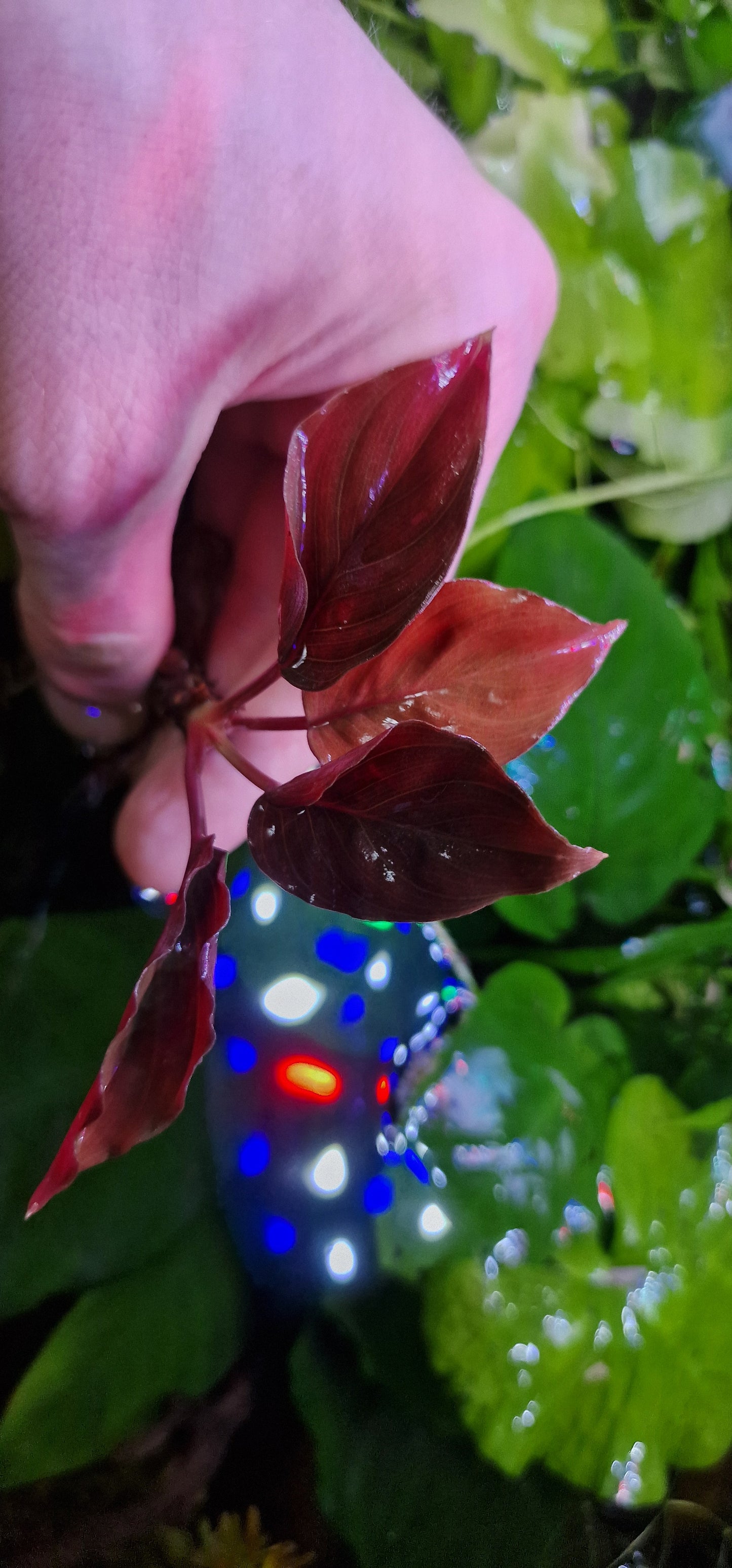Homalomema red 1 plant
Homalomema red 1 plant
Couldn't load pickup availability
Homalomena 'Red' – 1 plant
ENGLISH
Homalomena 'Red' is an uncommon but highly appreciated plant, admired for its velvety burgundy foliage and compact growth. Native to the tropical lowlands of Borneo and Sumatra, it thrives in high humidity and warm temperatures, making it perfect for terrariums and paludariums. Part of the Araceae family, it shares structural traits with Anubias and Philodendron.
Leaves reach 7–15 cm and grow from a creeping rhizome, forming a symmetrical rosette. Under strong indirect light (LED 5000–7000K, 60–90 µmol PAR), leaf coloration intensifies, turning deep wine-red. It prefers a moist, well-draining substrate—ideally a mix of sphagnum moss, perlite, and akadama—with temperatures between 22–28°C and humidity above 80%.
While Homalomena 'Red' does produce inflorescences with a typical Araceae structure—spathe and spadix, divided into female flowers at the base and male flowers above—the plant requires specific rainforest insects (mainly beetles and midges) for pollination. In nature, the spadix heats up and releases subtle odors to attract pollinators. However, in cultivation, these conditions are difficult to replicate, and pollination almost never occurs.
This is why propagation is done exclusively by rhizome division. Once the plant forms side shoots with 2–3 leaves, the rhizome can be gently split. Each section is replanted in moist substrate and allowed to recover for 2–3 weeks. Growth is slow, with new leaves emerging every few weeks.
Though not extremely rare, Homalomena 'Red' is still hard to find in stable, mature form. Its rich color, slow growth, and clean lines make it an elegant focal point in any tropical setup. Limited availability—ideal for collectors looking for contrast and structure without high maintenance.
---
ITALIANO
Homalomena 'Red' è una pianta poco comune ma molto apprezzata, celebre per le sue foglie rosso porpora e la crescita ordinata. Originaria delle pianure tropicali di Borneo e Sumatra, ama temperature calde e umidità elevata: l’ambiente ideale è un paludario o un terrario ben curato. Appartiene alla famiglia delle Araceae, come Anubias e Philodendron.
Le foglie, lunghe 7–15 cm, crescono da un rizoma strisciante formando una rosetta compatta. Con luce LED indiretta e intensa (5000–7000K, 60–90 µmol PAR), il colore si scurisce fino a un rosso vino profondo. Va coltivata in un substrato umido ma ben drenato (es. sfagno + perlite + akadama), a 22–28°C e con umidità sopra l’80%.
In natura produce un’infiorescenza tipica delle Araceae, con spata e spadice: i fiori femminili sono alla base, quelli maschili in alto. La pianta rilascia calore e odori leggeri per attirare coleotteri tropicali che la impollinano. Tuttavia, in coltivazione, questi insetti mancano e le condizioni non bastano per l’impollinazione, che non avviene quasi mai.
Per questo motivo la propagazione avviene esclusivamente per divisione del rizoma. Quando la pianta sviluppa germogli laterali con almeno 2–3 foglie, si può dividere con cautela. Ogni sezione va piantata in substrato umido e lasciata recuperare per 2–3 settimane. La crescita è lenta ma costante.
Pur non essendo rarissima, è comunque difficile trovarla in forma adulta e stabile. Perfetta per dare struttura, colore e ordine a un layout tropicale senza richiedere cure eccessive. Pochi esemplari disponibili.
---
FRANÇAIS
Homalomena 'Red' est une plante tropicale peu commune mais très recherchée pour son feuillage rouge bordeaux et sa croissance compacte. Originaire des plaines humides de Bornéo et Sumatra, elle aime la chaleur et une humidité constante, ce qui en fait un excellent choix pour les terrariums et paludariums. Elle fait partie de la famille des Araceae, comme les Anubias et les Philodendrons.
Les feuilles, mesurant 7 à 15 cm, poussent depuis un rhizome rampant et forment une rosette symétrique. Sous lumière LED indirecte (5000–7000K, 60–90 µmol PAR), elles prennent une teinte rouge foncé intense. Le substrat idéal est drainant et humide (sphaigne + perlite + akadama), avec une température de 22–28°C et une humidité supérieure à 80 %.
La plante produit une inflorescence en spathe et spadice, typique des Araceae : les fleurs femelles se trouvent à la base, les mâles au sommet. Le spadice chauffe et libère des arômes subtils pour attirer les insectes tropicaux. Mais en culture, l’impollination est quasiment impossible, faute d’insectes adaptés et de conditions naturelles.
Ainsi, la propagation se fait uniquement par division du rhizome. Lorsque la plante développe des pousses latérales avec 2–3 feuilles, on peut séparer le rhizome et replanter chaque morceau. Une période d’adaptation de 2 à 3 semaines est nécessaire. La croissance est lente, mais régulière.
Pas extrêmement rare, Homalomena 'Red' reste difficile à trouver sous forme adulte. Elle est parfaite pour apporter contraste et élégance dans un environnement tropical. Disponibilité limitée.
---
DEUTSCH
Homalomena 'Red' ist eine tropische Pflanze, die wegen ihres samtigen, dunkelroten Laubs und ihrer kompakten Wuchsform geschätzt wird. Ursprünglich aus den feuchtwarmen Tieflandwäldern von Borneo und Sumatra, gedeiht sie am besten bei hoher Luftfeuchtigkeit und konstanten Temperaturen. Sie gehört zur Familie der Araceae und ist mit Anubias und Philodendron verwandt.
Die 7–15 cm langen Blätter wachsen aus einem kriechenden Rhizom und bilden eine symmetrische Rosette. Unter starker, indirekter Beleuchtung (LED 5000–7000K, 60–90 µmol PAR) intensiviert sich die Rotfärbung. Das ideale Substrat ist locker und feucht (z. B. Sphagnum, Perlit und Akadama). Optimal: 22–28 °C und über 80 % Luftfeuchtigkeit.
Die Pflanze bildet typische Araceen-Infloreszenzen aus Spatha und Spadix, mit weiblichen Blüten unten und männlichen oben. Der Spadix erwärmt sich und verströmt einen dezenten Duft, um tropische Insekten – vor allem Käfer – anzulocken. In Kultur ist eine Bestäubung jedoch praktisch ausgeschlossen, da diese Insekten fehlen.
Daher erfolgt die Vermehrung ausschließlich durch Teilung des Rhizoms. Sobald die Pflanze 2–3 Blätter pro Seitentrieb entwickelt hat, kann sie vorsichtig geteilt werden. Jede Teilung wird in feuchtes Substrat gepflanzt und 2–3 Wochen lang stabil gehalten. Das Wachstum ist langsam, aber stetig.
Zwar nicht extrem selten, aber dennoch selten im Handel erhältlich – besonders in stabiler, ausgewachsener Form. Ideal für alle, die ein tropisches, elegantes Layout suchen. Begrenzte Stückzahl.


